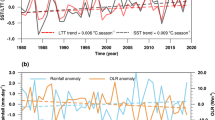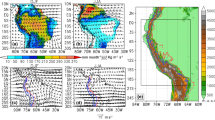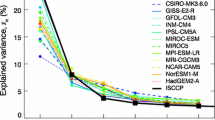Abstract
Tropical-extratropical cloud band systems over southern Africa, known as tropical temperate troughs (TTTs), are known to contribute substantially to South African summer rainfall. This study performs a comprehensive assessment of the seasonal cycle and rainfall contribution of TTTs by using a novel object-based strategy that explicitly tracks these systems for their full life cycle. The methodology incorporates a simple assignment of station rainfall data to each event, thereby creating a database containing detailed rainfall characteristics for each TTT. This is used to explore the importance of TTTs for rain days and climatological rainfall totals in October–March. Average contributions range from 30 to 60 % with substantial spatial heterogeneity observed. TTT rainfall contributions over the Highveld and eastern escarpment are lower than expected. A short analysis of TTT rainfall variability indicates TTTs provide substantial, but not dominant, intraseasonal and interannual variability in station rainfall totals. TTTs are however responsible for a high proportion of heavy rainfall days. Of 52 extreme rainfall events in the 1979–1999 period, 30 are associated with these tropical-extratropical interactions. Cut-off lows were included in the evolution of 6 of these TTTs. The study concludes with an analysis of the question: does the Madden-Julian Oscillation influence the intensity of TTT rainfall over South Africa? Results suggest a weak but significant suppression (enhancement) of intensity during phase 1(6).











Similar content being viewed by others
References
Blamey RC, Reason CJC (2012) Mesoscale convective complexes over southern Africa. J Clim 25:753–766
Cook C, Reason CJC, Hewitson BC (2004) Wet and dry spells within particularly wet and dry summers in the South African summer rainfall region. Clim Res 26:17–31
Crétat J, Richard Y, Pohl B, Rouault M, Reason CJC, Fauchereau N (2012) Recurrent daily rainfall patterns over South Africa and associated dynamics during the core of the austral summer. Int J Climatol 32(2):261–273. doi:10.1002/joc.2266
D’Abreton P, Lindesay J (1993) Water vapour transport over southern Africa during wet and dry early and late summer months. Int J Climatol 13:151–170
D’Abreton PC, Tyson PD (1995) Divergent and non-divergent water vapour transport over southern Africa during wet and dry conditions. Meteor Atmos Phys 55:47–59
Diab RD, Preston-Whyte RA, Washington R (1991) Distribution of rainfall by synoptic type over Natal, South Africa. Int J Climatol 11:877–888
Fauchereau N, Pohl B, Reason C, Rouault M, Richard Y (2009) Recurrent daily OLR patterns in the Southern Africa / Southwest Indian Ocean region, implications for South African rainfall and teleconnections. Clim Dyn 32:575–591
Favre A, Hewitson B, Tadross M, Lennard C, Cerezo-Mota R (2012) Relationships between cut-off lows and the semi-annual and southern oscillations. Clim Dyn 38(7):1473–1487. doi:10.1007/s00382-011-1030-4
Harangozo SA, Harrison MSJ (1983) On the use of synoptic data in indicating the presence of cloud bands over southern Africa. S Afr J Sci 79(10):413–414
Harrison MSJ (1984) A generalized classification of South African rain-bearing synoptic systems. J Climatol 4:547–560
Harrison MSJ (1986) A synoptic climatology of South African rainfall variations. PhD thesis, University of Witwatersrand, Johannesburg
Hart N, Reason CJC, Fauchereau N (2010) Tropical-extratropical interactions over southern Africa: three cases of heavy summer season rainfall. Mon Wea Rev 138:2608–2623
Hart N, Reason CJC, Fauchereau N (2012) Building a tropical-extratropical cloud band metbot. Mon Wea Rev 140(12):4005–4016. doi:10.1175/MWR-D-12-00127.1
Liebman B, Smith CA (1996) Description of complete (interpolated) outgoing longwave radiation dataset. Bull Am Meteor Soc 77:1275–1277
Lynch S (2003) Development of a RASTER database of annual, monthly and daily rainfall for Southern Africa. Report 1156/1/03, WRC
Madden RA, Julian PR (1994) Observations of the 40-50 tropical oscillation: a review. Mon Wea Rev 122:814–837
Manhique A, Reason CJC, Rydberg L, Fauchereau N (2011) El Nino Southern Oscillation and Indian Ocean sea surface temperature and their relation with tropical temperate troughs over southern Africa. Int J Climatol 31(1):1–13. doi:10.1002/joc.2050
Muller A, Reason CJC, Fauchereau N (2008) Extreme rainfall in the Namib Desert during late summer 2006 and influences of the regional ocean variability. Int J Climatol 28:1061–1070. doi:10.1002/joc.1603
Pohl B, Richard Y, Fauchereau N (2007) The influence of the Madden Julian Oscillation on southern African summer rainfall. J Clim 11:2659–2674
Pohl B, Fauchereau N, Richard Y, Rouault M, Reason CJC (2009) Interactions between synoptic, intraseasonal and interannual convective variability over Southern Africa. Clim Dyn 33:1033–1050
Polo I, Ullmann A, Roucou P, Fontaine B (2011) Weather regimes in the Euro-Atlantic and Mediterranean sector, and relationship with West African rainfall over the 1989-2008 period from a self-organizing maps approach. J Clim 24:3423–3432
Singleton AT, Reason CJC (2007) A numerical model study of an intense cutoff low pressure system over South Africa. Mon Wea Rev 135:1128–1150
Taljaard JJ (1996) Atmospheric circulation systems, synoptic climatology and weather phenomena of South Africa. Technical Paper 32, South African Weather Bureau, Pretoria
Todd MC, Washington R (1998) Extreme daily rainfall in southern African and southwest Indian Ocean tropical-temperate links. S Afr J Sci 94:64–70
Tyson PD, Preston-Whyte RA (2000) The weather and climate of southern Africa, 2nd edn. Oxford University Press, Oxford
Usman MT, Reason CJC (2004) Dry spell frequencies and their variability over southern Africa. Clim Res 26:199–211
Washington R, Todd M (1999) Tropical-temperate links in Southern Africa and Southwest Indian Ocean satellite-derived daily rainfall. Int J Climatol 19:1601–1616
Wheeler MC, Hendon HH (2004) an all-season real-time multivariate MJO index: development of an index for monitoring and prediction. Mon Wea Rev 132:1917–1932
Acknowledgments
Benjamin Pohl is thanked for his preprocessing of the WRC station rainfall data. Interpolated OLR data was obtained from NOAA/OAR/ESRL PSD, Boulder, Colorado, USA through http://www.cdc.noaa.gov. The first author gratefully acknowledges funding through SANAP and a D & E Potter Foundation PhD Fellowship. Two anonymous reviewers are thanked for their suggestions.
Author information
Authors and Affiliations
Corresponding author
Rights and permissions
About this article
Cite this article
Hart, N.C.G., Reason, C.J.C. & Fauchereau, N. Cloud bands over southern Africa: seasonality, contribution to rainfall variability and modulation by the MJO. Clim Dyn 41, 1199–1212 (2013). https://doi.org/10.1007/s00382-012-1589-4
Received:
Accepted:
Published:
Issue Date:
DOI: https://doi.org/10.1007/s00382-012-1589-4




